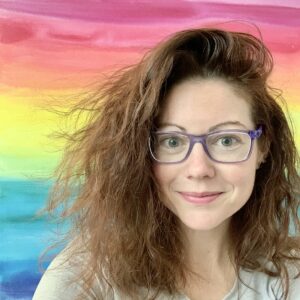
Today, we’re sharing some insights from my recent conversation with Camille Gerrick. Camille is a neurodivergent artist living in Charlottesville, Virginia. And while her narcolepsy and ADHD present challenges to running a business and doing all the normal things grownups are supposed to do, she prefers to think of these conditions as her artistic superpowers.
What does it mean when someone is neurodivergent?
Being neurodivergent or neurodiverse means that the brain is wired differently from everyone else’s. Some conditions that might fall under this spectrum of neurodiversity are ADHD, autism, and dyslexia. When you think about neurodiversity, it’s important to acknowledge that just because that brain is different, it doesn’t mean that it’s any less than a neurotypical brain. Instead, it’s more about focusing on the strengths that neurodiversity will bring to the situation. For example, people with ADHD may be notoriously bad with time management, but they can also be very passionate and driven. And when we’re interested in something, we can spend hours on it and not even realize it—thinking of our differences as strengths.
You grew up as a kid in the 80s and 90s; how has that affected your art style?
I remember having a lot of really obnoxious outfits like these crazy patterns with squiggles and triangles and loud colors. The big scrunchies, the side ponytails, and I guess I just never really grew out of that, to be honest. Colors just make me happy. When I was a kid in elementary school, Lisa Frank was a big deal, and everybody had the folders with the cute rainbow animals and the trapper keeper for all their school stuff. And I just never grew out of that phase. Maybe it’s childish, but it’s fun. And it’s harmless.
I just started reading the Aesthetics Of Joy by a designer named Ingrid Fetell Lee. The premise of the book is that we’ve been taught through ancient traditions that the source of joy lies within us. But, a growing body of research is starting to support the idea that tangible objects can also spark that feeling of joy. In the book, Ingrid embarks on this study to find out what things spark joy, and color was one of her findings.
How did you get started?
It always sounds cheesy to say; I’ve been creative since I was a child. But there’s really not a time I can remember not being enamored with drawing or painting or the creative process. Growing up, we had this little kids’ table with chairs that had pockets on the back full of all our crayons and markers. I remember sitting at that table and coloring away. My dad is a writer and a musician, and my mom is a teacher, so it’s just something we grew up with, being encouraged to be creative. My mom was very anti-TV as well so that probably helped, if we can’t watch TV, maybe we’ll make something.
As a kid, I was always given craft special interest books like learning calligraphy or origami with a dollar bill, and oftentimes, they came with all the supplies you need to do what was in the book. Specifically, there was one book about macrame friendship bracelets, and I latched on to that book; I learned how to do all these different knots. I actually started my first business when I was in elementary school, selling macrame friendship bracelets on the playground. I would take my little box of embroidery thread and pull custom colors for people to make them custom color friendship bracelets during recess. Around this time, my grandfather, who owned his own landscaping business in South Florida – landscaping was a big deal – started having conversations with me about charging for my products. He’d say you need to think about how much it costs you to make it and make sure that you charge the right amount so that you’re not losing money. And then you need to decide what percentage of what you make you’re going to invest back into materials or growing the business and what percentage do you want to save. So from a very young age, those conversations about entrepreneurship were had through my grandfather.
You’ve mentioned throughout your story (you’ll have to listen to the podcast to find out more) that you also cope with chronic issues like pain; how do you do art while dealing with those issues?
Yeah, I have a lot of chronic pain from when I was in the military and art helps me cope with that. With art, I get into that flow state where your sense of time, like physical sensations from your body, kind of cease to exist, and you’re 100% in the moment, focused on what you’re drawing or creating. I need that in my life on a very regular basis. It helps me feel sane. It’s something that takes my mind off these health issues – it’s a mental escape from really anything adulty in life.
Where You Can Find Camille:
- Website: www.camilovescolor.com
- Facebook: camillegerrick
- Instagram: @cami.loves.color
- TikTok: @cami.loves.color
- LinkedIn: camille-gerrick
This podcast and all past episodes are available to listen to now. You can also subscribe to Get Under The Surface podcasts on all major platforms (Apple Podcasts, Google Podcasts, Spotify, etc.).
Want more from Cuppa SEO Web Design?
